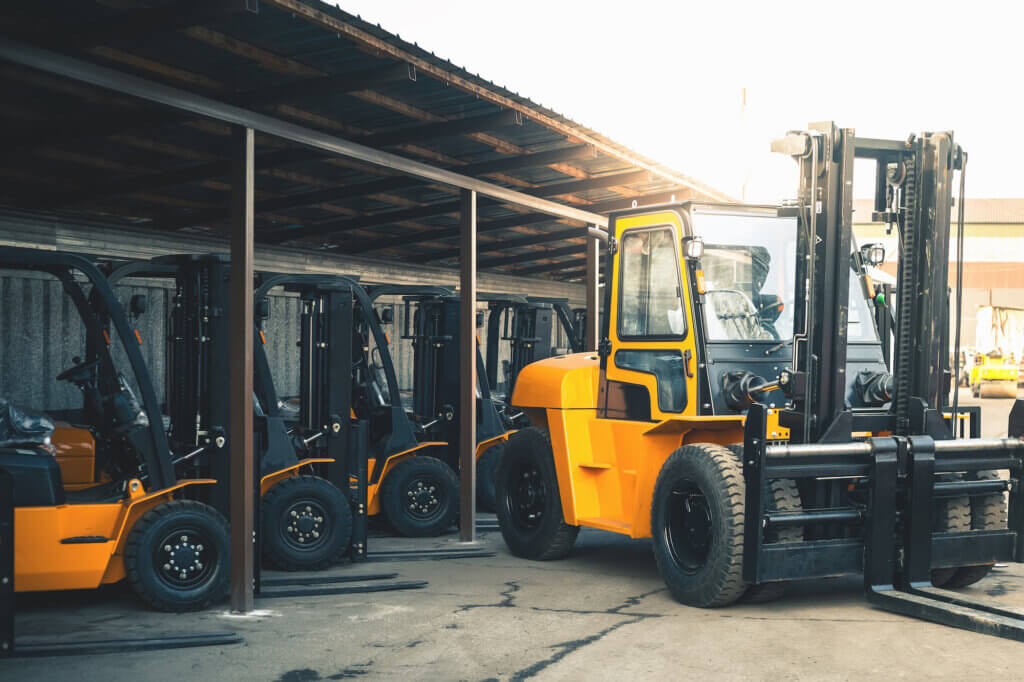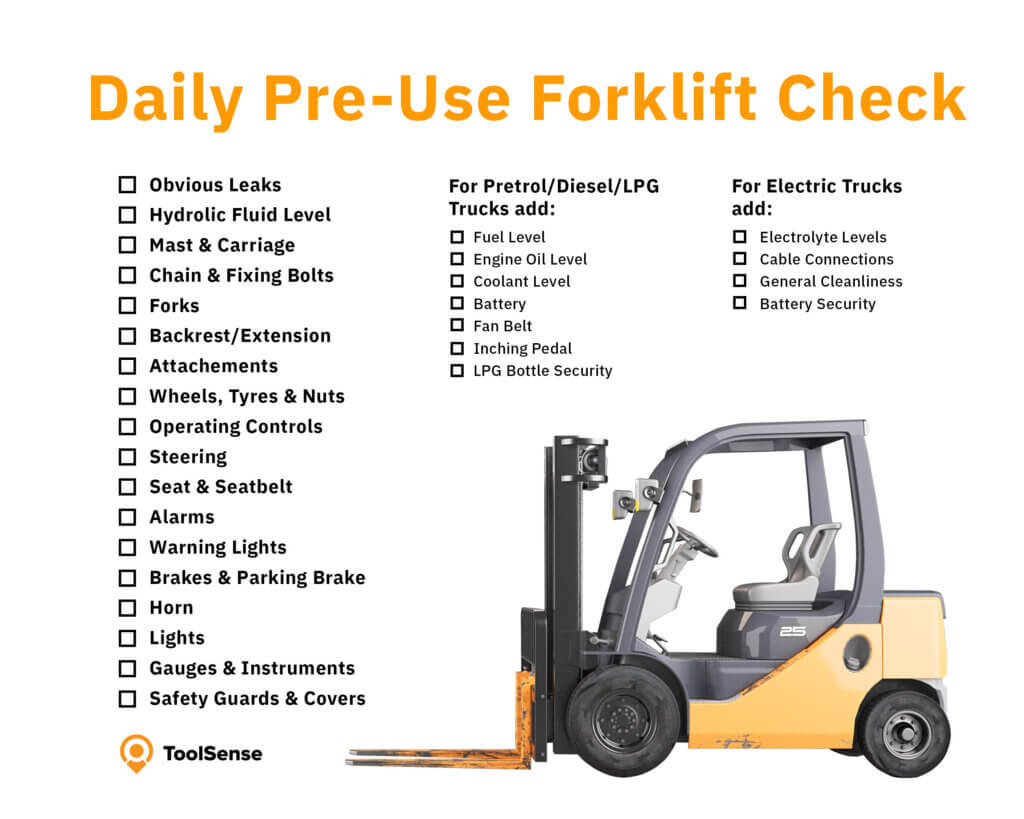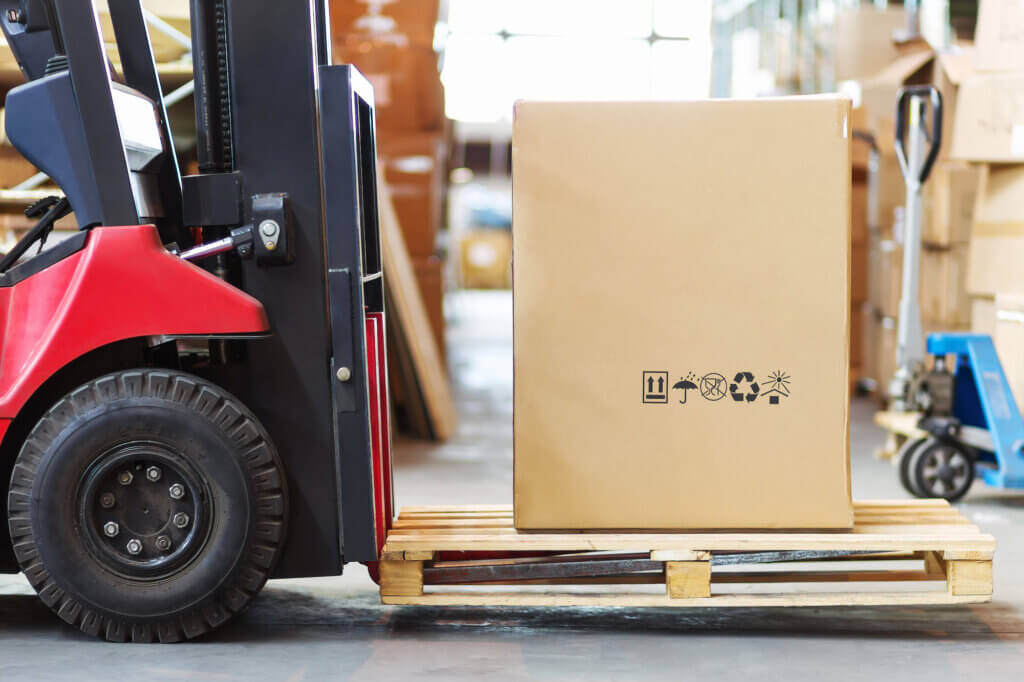Forklifts or forklift trucks are useful pieces of equipment that many industries rely on for their daily workflow. They can be found in warehouses, manufacturing companies, dockyards, recycling facilities, and many more places. The pronged device at the front of the forklift helps operators move and lift heavy or bulky loads effortlessly. This article explains the difference between various types of forklift inspections, how they contribute to a safer and more efficient workplace, and how a suitable software can help you with your forklift management and maintenance.
Key Takeaways
- Forklifts or forklift trucks are vehicles with a pronged device that are used to lift and transport heavy items.
- LOLER 1998 and PUWER 1998 regulate how and how often forklifts should be inspected.
- Forklift checks should be carried out daily (forklift pre-use checks), weekly, and every 6 to 12 months.
- Examples of things that should be inspected during every pre-use check are safety features, tyres, or oil and fuel levels as well as the immediate environment.
Staying ahead of the requirements and quality control for safety inspections made easy: Flexible rules, pre-configured and custom inspections and powerful automations ensure a flawless operation of your assets and reduce costs.
What Are Forklift Checks?
Like the majority of machines and equipment, forklift trucks, too, need to be checked at regular intervals to ensure that they are in working order and safe to operate. This can include daily checks, weekly audits, thorough inspections and either visual or operational checks. Those checks are regulated by law under LOLER 1998 (Lifting Operations and Lifting Equipment Regulations) and PUWER 1998 (Provision and Use of Work Equipment Regulations).

Daily, Weekly and Thorough Inspections
There are different types of forklift checks that can be divided into how often these inspections take place or how these checks are conducted. Firstly, those checks can either be visual or operational.During a visual check, the forklift truck is inspected from the outside and checked for any visible faults or damage. This can include checking for damage to the tyres or the correct pressure of air, obvious leaks, or general damage to the chassis. Operational checks, on the other hand, include testing the forklift’s functionality while it is in use to make sure the engine, safety features, and mechanical parts function as they should.
Forklift inspections can also be divided into how frequently or how extensively they are conducted. There are three types of inspections:
- Daily checks
- Weekly checks
- Thorough examination

Daily or Pre-Operational Forklift Inspections
Daily forklift inspections, also called forklift pre-use checks or pre-operational checks, are meant to be conducted by the forklift operator either at the beginning of the workday, the beginning of the shift, or before every use. That is where the term “pre-use check” comes from. These forklift daily checks are not optional, but a legal requirement to ensure the safety of the operator and other people in the vicinity.
Forklift operator pre-use checks shouldn’t be compared to a thorough examination that only takes place every 6 to 12 months. Instead, they are quick checks used to identify small problems before they have a chance of turning into big issues that can lead to downtime or workplace accidents. Since forklift operators aren’t specialists, they can’t be expected to find and fix major machine flaws, so a daily check is kept as simple as possible. The best course of action is to compile a forklift daily checklist for all operators to follow so that no detail is forgotten. These pre-use checklists can include:
- General state and any obvious damage
- Tyres
- Engine oil level
- Hydraulic fluid level
- Safety features (brakes, lights, alarms, sensors)
- Battery
- Nuts, bolts, and chains
- Hydraulic systems
- Parking brake
- Warning lights and other warning devices
- Forks
- Exposed wires
- Fluid leaks
- Seat and seat belt
- Checking your environment for potential sources of accidents
ToolSense is trusted by 700+ companies



Weekly Forklift Checks
Weekly forklift inspections and their checklists can look quite similar to daily ones in terms of what needs to be checked. However, weekly checks are more extensive and require more time and effort to conduct. Especially the hydraulics systems, chains, and transmission oil levels should be inspected in-depth to avoid downtime or costly repairs in case of breakdowns. While daily checks are conducted by the forklift operator, weekly audits could also be done by an expert engineer.
Thorough Examination
Similarly to cars and other vehicles needing a yearly MOT, forklifts also need to undergo a thorough examination under the Lifting Operations and Lifting Equipment Regulations 1998 (LOLER) and Provision and Use of Work Equipment Regulations 1998 (PUWER). During a LOLER inspection, a competent person thoroughly examines equipment that is used for lifting, which includes forklifts. The HSE (Health and Safety Executive) offers specific guidelines about who is qualified to do this. After the forklift inspection is conducted and everything is working correctly, a certificate (a written report) will be issued.
Forklift Pre-Check Routine
This Health and Safety Authority of Ireland video on vehicle safety in the workplace should give you a better understanding of the routine of pre-testing forklifts.
The Importance of Checks Before Forklift Operations
Forklift pre-use checks, weekly checks, and thorough examination can seem like a time-consuming and expensive effort at first, but they serve an important purpose that should make companies think twice before skipping the next forklift check. While they do cost time and money to conduct, they actually contribute to saving your company time and money in the long run.
By conducting daily, weekly and yearly checks, you can ensure that your equipment is kept in top shape. By resolving small problems or normal wear and tear immediately, your company saves money on larger, unexpected repairs. Especially forklift pre-use checks or more extensive weekly checks can uncover minor faults that would have led to unexpected downtime during the day and required more extensive repairs, potentially halting your workflow for longer periods of time. That way, regular inspections boost your efficiency and prevent a loss in revenue due to machine downtime.
However, saving time and money is not the only benefit your company gains from forklift checks. The safety of your staff and other people in the vicinity during a forklift operation is another important factor. Just like cars, forklifts can cause accidents that are, in part, due to mechanical failure or malfunctioning safety features. These are easily preventable through regular forklift checks.

How Does Forklift Fleet Management Software Help?
ToolSense is a clever asset management solution for many different use cases. You can manage and maintain your forklift fleet and other types of equipment through an easy-to-use platform that can improve the efficiency of your workflow and save your company a lot of money. Existing forklifts and other assets can be added to the ToolSense database through a simple Excel import and equipped with a unique QR code. Every time the forklift truck is used, maintained, repaired, or a problem occurs, your forklift operator scans the QR code and reports the equipment statistics to the system.
The forklift fleet management software allows you to track location, runtimes, downtime, and keep an eye on all maintenance tasks. Daily, weekly, and yearly inspections are stored in the system and employees will receive a reminder whenever a check is due. You can also incorporate customised daily and weekly forklift inspection checklists that operators can use to conduct their audits. This ensures that no dates and no details are forgotten.
Alexander Manafi (CEO) Gives You a Private Tour of Custom Forms & Checklists
Staying on top of your forklift checks also means knowing which maintenance tasks were performed. ToolSense saves all the information you need in your asset’s lifecycle folder for later review and offers fantastic and thorough analytics and reporting tools. That way, you know exactly which forklift was checked, how long they have been in use, and which asset caused the most downtime and repair requests. This information can be used in your company’s decision-making process.
Conclusion: Keep Track of Your Forklift Checks With ToolSense
Forklift checks are a vital part of your everyday workflow if you operate a forklift fleet – not just because they are a legal requirement in the United Kingdom, but also because they ensure the safety of your staff and keep your equipment in top shape. By utilising a forklift fleet management software, you can automate many important maintenance steps, which will save your company time and money in the long run.
FAQ
Your forklift daily inspection checklist can include visual checks, such as for damages or leaks, as well as operational checks that include safety features, fuel and oil levels, and general functionality.
Forklift inspections can be done visually or operationally. Visually, you can check for cracks, leaks, or other types of damage. Operationally, you test the function of the forklift in general as well as important safety features.
Forklift trucks, also called forklifts, are powerful tools used to lift and transport heavy loads. The pronged device at the front of the truck is especially useful in warehouses, dockyards, recycling facilities, or in manufacturing businesses.
A forklift operator should check the vehicle for visible damage, and flat or broken tyres. Keeping an eye out for fuel and engine oil levels or malfunctioning safety features is also part of the usual forklift pre-use check.
Regular forklift checks are a legal requirement in the United Kingdom under LOLER 1998 and PUWER 1998, which regulate safety measures as well as lifting equipment, and are defined by the Health and Safety Executive (HSE).
Extensive and thorough inspections should take place every 6 to 12 months, whereas smaller checks can be conducted weekly. Some parts of the forklift, like safety features or tyres, should be checked before every use.

